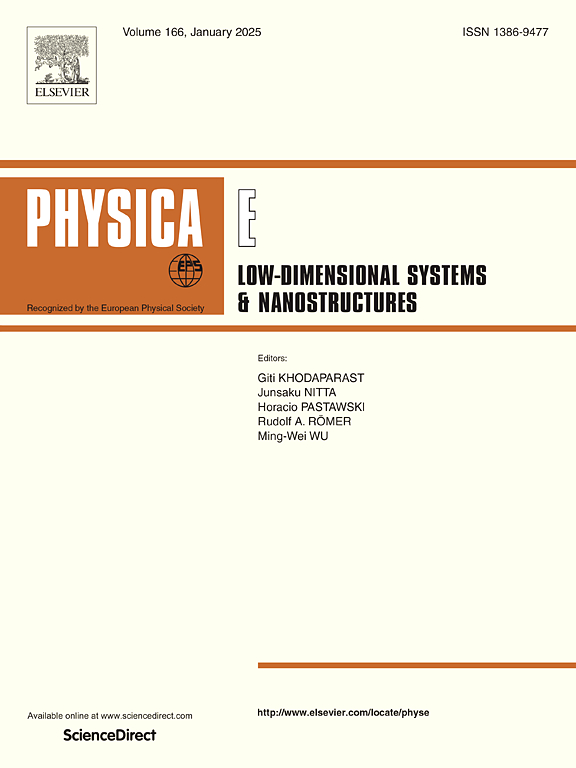通过碳纳米管上纳米带的自滚动,石墨烯/石墨烯纳米卷的可调形态:一个理论预测
IF 2.9
3区 物理与天体物理
Q3 NANOSCIENCE & NANOTECHNOLOGY
Physica E-low-dimensional Systems & Nanostructures
Pub Date : 2025-06-28
DOI:10.1016/j.physe.2025.116324
引用次数: 0
摘要
石墨烯/石墨烯纳米卷(GY/G-NS)异质结构以其增强的协同性能而闻名,在催化和能源应用方面具有巨大的潜力。为了满足特定的应用需求,非常需要具有可调形态的GY/G-NSs。在这项研究中,我们介绍了三种模型,每个模型都由放置在碳纳米管(CNT)附近的石墨炔和石墨烯纳米带组成,具有不同的初始相对位置,以寻找合适的方法来制造GY/G-NSs。分子动力学模拟表明,当碳纳米管半径超过一个临界值时,可以有效地触发混合纳米带的自滚动形成GY/G-NSs。使用这些模型可以发现两种类型的配置——交错配置和覆盖配置。这些结构可以通过调整纳米带长度或碳纳米管半径来切换。此外,纳米卷在覆盖的GY/G-NS内的相对位置可以通过调节碳纳米管两侧条带的释放模式来控制。这项研究为石墨烯和石墨烯在高级应用中的定制异质结的定制使用提供了见解。本文章由计算机程序翻译,如有差异,请以英文原文为准。

Tunable morphology of graphyne/graphene nanoscrolls via self-scrolling of nanoribbons on a CNT: A theoretical prediction
Graphyne/graphene nanoscroll (GY/G-NS) heterostructures, known for their enhanced synergistic performance, hold significant potential in catalysis and energy applications. To meet specific application needs, GY/G-NSs with tunable morphologies are highly desirable. In this study, we introduce three models, each consisting of a graphyne and a graphene nanoribbon placed near a carbon nanotube (CNT), with different initial relative positions for finding an appropriate way to fabricate GY/G-NSs. Molecular dynamics simulations reveal that when the CNT radius exceeds a critical value, it can effectively trigger the self-scrolling of the hybrid nanoribbons to form GY/G-NSs. Two types of configurations—interlaced and covered—are discovered using these models. These configurations can be switched by adjusting the nanoribbon lengths or the CNT radius. Furthermore, the relative positioning of the nanoscrolls within a covered GY/G-NS can be controlled by modulating the release mode of the ribbons on opposite sides of the CNT. This study provides insights into the tailored use of graphyne and graphene for custom heterojunctions in advanced applications.
求助全文
通过发布文献求助,成功后即可免费获取论文全文。
去求助
来源期刊
CiteScore
7.30
自引率
6.10%
发文量
356
审稿时长
65 days
期刊介绍:
Physica E: Low-dimensional systems and nanostructures contains papers and invited review articles on the fundamental and applied aspects of physics in low-dimensional electron systems, in semiconductor heterostructures, oxide interfaces, quantum wells and superlattices, quantum wires and dots, novel quantum states of matter such as topological insulators, and Weyl semimetals.
Both theoretical and experimental contributions are invited. Topics suitable for publication in this journal include spin related phenomena, optical and transport properties, many-body effects, integer and fractional quantum Hall effects, quantum spin Hall effect, single electron effects and devices, Majorana fermions, and other novel phenomena.
Keywords:
• topological insulators/superconductors, majorana fermions, Wyel semimetals;
• quantum and neuromorphic computing/quantum information physics and devices based on low dimensional systems;
• layered superconductivity, low dimensional systems with superconducting proximity effect;
• 2D materials such as transition metal dichalcogenides;
• oxide heterostructures including ZnO, SrTiO3 etc;
• carbon nanostructures (graphene, carbon nanotubes, diamond NV center, etc.)
• quantum wells and superlattices;
• quantum Hall effect, quantum spin Hall effect, quantum anomalous Hall effect;
• optical- and phonons-related phenomena;
• magnetic-semiconductor structures;
• charge/spin-, magnon-, skyrmion-, Cooper pair- and majorana fermion- transport and tunneling;
• ultra-fast nonlinear optical phenomena;
• novel devices and applications (such as high performance sensor, solar cell, etc);
• novel growth and fabrication techniques for nanostructures

 求助内容:
求助内容: 应助结果提醒方式:
应助结果提醒方式:


